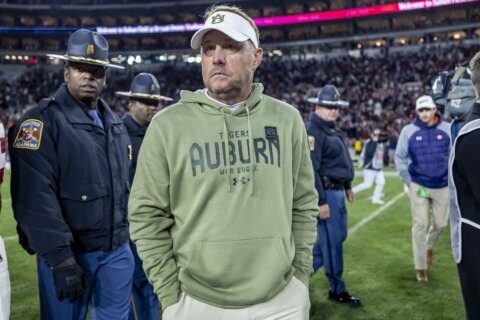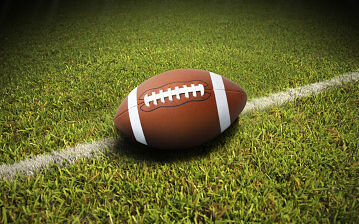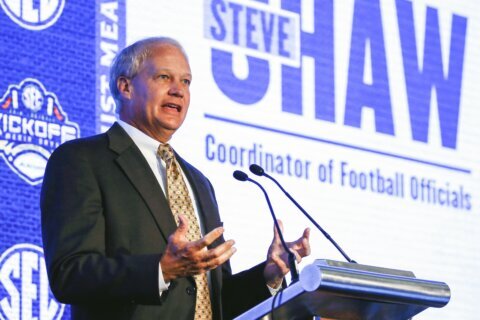Louisville coach Jeff Brohm looks forward to being that voice in his player’s ear – much like he enjoyed hearing one as an NFL quarterback in the late 1990s.
Brohm just didn’t expect college football to take 30 years to follow suit with in-helmet communications.
“The NFL has used them ever since I played, which was a long time ago,” the second-year Cardinals coach recalled. “So it should have been put into place. But I do think it’s time, and you’ve just got to figure out the best way to utilize it.”
After years of debate over cost and equity, the NCAA approved widespread use of helmet communication in April for the Bowl Subdivision, giving 134 teams at the top of the sport the option to use it beginning this season. It will officially debut during this week’s full slate of openers and join traditional methods such as huddles, hand signals, wristband play scripts and those clever sideline signs bearing emojis and animation to call plays.
Teams have spent the past four months preparing how to use coach-to-player helmet communications though it’s not clear how many will use it. Some programs experimented with it during bowl season last year, but it was optional then and still is.
A single player on offense and a single player on defense will be able to hear from a coach; communication will be turned off with 15 seconds remaining on the play clock or when the ball is snapped, whichever comes first. Designated players will sport a green dot on their helmets.
“On offense, it’s seismic,” Nebraska coach Matt Ruhle said. “You are able to remind the quarterback not just of the play but also the situation. Just the thought process, right? ‘Hey, it’s third and 7, two downs, take the check down if it’s there and it gives us fourth and 3.’”
There is anticipation that the new technology will impact offensive pace and execution and help the defense respond.
“It’s definitely an advantage, being able to have that communication with (QBs coach and play-caller Joe) Sloan, making sure we’re in the correct play, running the right thing,” LSU quarterback Garrett Nussmeier said.
Defense-minded Kentucky coach Mark Stoops said, “It helps us with subtle movements up front on things that we do, from where we shade guys, where we move things compared to the formation and what we think we’re getting. It helps remind them and essentially makes some checks in that regard, even if they’re subtle or big changes.”
Long time coming
Years of discussion about cost and equitable use delayed approval of an electronic system similar to the NFL, which implemented transmitters between coaches and QBs in 1994 and then defensive players 14 years later. The Pro Football Hall of Fame says the innovation was introduced in 1956, when Ohio inventors John Campbell and George Sarles developed an audio receiver and pitched it to Cleveland Browns Paul Brown for quarterback George Ratterman. The Browns used it in an exhibition and several games before NFL Commissioner Bert Bell banned it.
Dallas Cowboys coach Mike McCarthy recalled the NFL’s approval to helmet communication decades later as “a transition” from signals and pointed to different parts of his body to demonstrate the gyrations done to relay calls. He also remembers working with many QBs who had different preferences.
“My experience is some guys, they want a lot of information,” said McCarthy, who coached the Green Bay Packers to a Super Bowl title in the 2010 season, “Some guys want as little as possible. Like Rich Gannon, you couldn’t get off quick enough. Brett Favre, you could talk to him all the way down to 15 seconds. So, I mean, just certain guys are different, so that’s what I found was the biggest transition going from signals to the helmet speaker because it’s different.”
Mixed reaction
Like any changes in sports, reactions on college football’s top tier already vary between yay and nay. Texas Tech coach Joey McGuire’s disapproval featured numerous adjectives along with a reminder that old habits will remain.
“It’s an absolutely horrible rule,” he said. “It’s really, really comical. You’re still going to see everybody signal. … We actually experimented with letting a linebacker that has it on tell the other linebacker and then they were going to communicate to the two levels. We got lit up like a Christmas tree. It was a fiasco.
“So, please, for all the other coaches we play, don’t signal. Have one guy trying to communicate it to everybody on the field whenever you’re playing college football in tempo.”
Approval of the communication came in the wake of allegations last fall of sign-stealing and impermissible scouting by Michigan, which the NCAA is investigating. The NCAA does not ban efforts to decipher an opponent’s sideline signs on game days — advanced, in-person scouting is banned — and that practice is likely to continue. It just becomes a little harder with players hearing plays straight from coaches’ mouths.
What to expect
It remains to be seen which side of the ball will benefit most from the technology. At the very least, plays could feature more clarity with perspectives that could benefit many positions.
Although Auburn coach Hugh Freeze hinted at throwing the communications “on the ground” earlier in fall camp as he adapts, he appeared intrigued about how it may streamline the pre-snap process — if not spark debate over whether to say more or less.
“I think everybody’s trying to maneuver around that,” he said. “You know, do we hold it until 15 seconds so that the defense can’t, and then you put it all on (Rebels quarterback) Payton (Thorne) or do we try to start with 30 seconds talking to him and knowing that they still could change with 15. We’re all dealing with that.”
___
AP sports writers Cliff Brunt, Dave Campbell, Schuyler Dixon, Dan Greenspan, Stephen Hawkins, Mark Long, Brett Martel, Steve Megargee, Eric Olson, Teresa M. Walker and John Zenor contributed.
___
Get poll alerts and updates on the AP Top 25 throughout the season. Sign up here. AP college football: https://apnews.com/hub/ap-top-25-college-football-poll and https://apnews.com/hub/college-football
Copyright © 2025 The Associated Press. All rights reserved. This material may not be published, broadcast, written or redistributed.







